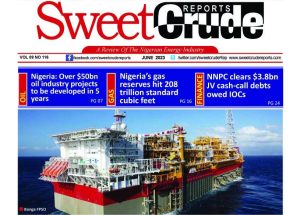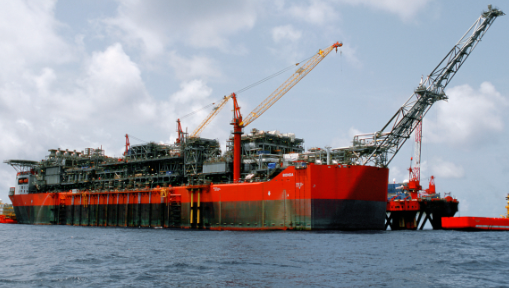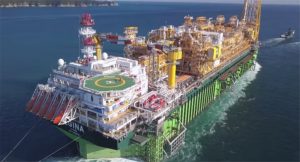 Hector Igbikiowubo
Hector Igbikiowubo
Lagos – Oil and gas industry observers have expressed huge concern over what they have described as “ambiguous reporting on Nigeria’s crude oil production over the years”, which has created room for all manner of speculations. Analysts, however, rely on data sourced from the Oganization of the Petroleum Exporting Countries, OPEC, website to obtain guidance on what the country reports as its daily output.
Speaking on what OPEC members declare as daily output, a ranking oil industry player noted that for strategic national interest, all OPEC member countries under declare their crude oil and gas production to give the impression that they are producing within the group’s stipulated allocation.
According to data sourced from OPEC, Nigeria’s crude oil production in February 2023 was reported at 1,380,000 barrels per day. This represents an increase from the previous number of 1,308,000 barrels per day for January 2023.
Going down memory lane, an oil industry observer said Nigeria’s crude oil production data is updated monthly, averaging 1,915,000 per day in January 2002 when Nigeria did not have any offshore deepwater prospect contributing to crude oil output.
At the time, crude oil production was from shallow water and swamp fields. In 2003, Shell Petroleum Development Company Nigeria Limited recorded one million barrels per day oil production, exactly two years before production from the Bonga deepwater field started contributing to its tally.
Some of the oil fields that contributed to Shell’s onshore oil production tally of one million barrels per day may have matured or been sold by the operator, but it would be disingenuous to give the impression that the company is not producing anything significant onshore anymore.
Since 2005, when the Bonga deepwater field came on stream, signaling Nigeria staking its rightful claim on this sphere of oil production, a few other deepwater fields have come into play, significantly altering the country’s crude oil production landscape.
A look at these deepwater that had come on stream in Nigeria since 2005 would clearly show the ambiguous reporting on Nigeria’s crude oil production. These fields include the following:
Bonga Oil & Gas field
The Shell Nigeria Exploration and Production Company Limited is the operator of the Bonga oil field on OML 118, located 120 nautical miles offshore the Niger Delta. Other

partners include NNPC Limited, TotalEnergies Upstream and Eni. In February 2023, the Bonga Floating Production Storage and Offloading, FPSO, vessel hit a one-billion-barrel oil export mark with daily output put at over 200,000.
Description
- This was the first deepwater project for Shell in Nigeria in a water depth of 3,000 feet located 120 km off coast of the Niger Delta, using a FPSO. The FPSO, measuring over 300 metres long, 75 metres wide and 33 metres tall, could extract and process up to 225,000 barrels of oil a day and store up to 2 million barrels of oil. It also has a gas export facility of 150 million standard cubic feet per day.
- Bonga North-West is located approximately 900 to 1,200 meters of water and has been developed with 12 subsea wells tied back into the Bonga main infrastructure.
- Bonga Phase 3 is an expansion of the Bonga Main development, with peak production expected to be some 50,000 barrels of oil equivalent. This is transported through existing pipelines to the Bonga FPSO.
Abo Oil field
Operated by ENI, the Abo field is located on OML 125, in the North-Western sector of the Nigerian Deepwater. Production started in 2003 and the partners are ENI – 50.19% and SNEPCO – 49.81%. The Abo oil field currently produces over 30,000 barrels of oil per day.
Description
- Abo Central, developed in a water depth ranging between 500 m and 800 m, is the first producing Nigerian deepwater oil field.
- Abo FPSO has a storage capacity of 900,000 barrels of oil and oil treatment capacity of up to 45,000 bpd, a water injection capacity of 30,000 bwpd and a gas injection capacity of 35 MMSCFD.
- The associated gas will be re-injected into the reservoir.
Agbami Oil field
The Agbami oil field was discovered in late 1998 and is operated by Chevron Nigeria Limited and other partners include Petrobras, NNPC Limited and Equinor ASA. It has an installed capacity to produce 250,000 barrels of oil per day, and 450 million cubic feet of gas. The current daily oil production from the Agbami oil field is 140,000.
Description
- The Agbami FPSO is moored in about 4,700 feet water depth, and at least 40 subsea wells will most likely be necessary to fully exploit the field.
- The FPSO will be designed to handle 250,000 barrels of oil per day, 450 million cubic feet of gas production per day and 450,000 barrels of injected water per day.
- Approximately 415 million cubic feet of gas per day will be re-injected. Designed to store approximately 2.2 million barrels of oil, the Agbami vessel is set to be on location for more than 20 years.
- The Agbami FPSO will have thirteen topside modules, which contain the main process and utility systems.
- Weighing approximately 30,000 tons, the vessel topsides will generate 75 megawatts of power and have living quarters for 100 personnel.
Akpo Oil field
The Akpo oil field operated by TotalEnergies Upstream is on OML 130, located 200 km Offshore Nigeria. Oil and gas production commenced in 2009 and the partners include TotalEnergies with a 24% interest, Nigerian National Petroleum Corporation (NNPC) and Sapetro, China’s CNOOC Ltd., and Brazil’s Petrobras. Akpo currently accounts for over 70,000 of crude oil and condensate per day and 145.00 Mmscf/d of natural gas.
Description
- Total’s first deepwater development in Nigeria
- Located 200 kilometers offshore Nigeria, lying in water depths of 1,300 to 1,500 meters.
- Its proved and probable reserves are estimated at 620 million barrels of condensate and more than 28 billion cubic meters of gas.
- Its subsea production system comprises 44 wells — 22 producers, 20 water injectors and two gas injectors — 100 kilometers of subsea flowlines, 80 kilometers of umbilical to manage and control production, and 14 risers tying the subsea network into the AKPO FPSO.
- The 310-meter-long, 61-meter-wide and 31-meter-high FPSO is moored by 12 anchor lines and weighs nearly 100,000 metric tons. It is designed to process 185,000 barrels of condensate and 15 million cubic meters of gas a day and to store up to two million barrels of condensate.
- Gas is piped 150 kilometers to the Amenam Kpono Oil Field platforms, from where it is sent to the Nigeria LNG Terminal
Egina Oil field
The Egina oil field on OML 130 is operated by TotalEnergies Upstream Limited and shareholders include NNPC Limited, SAPETRO, CNOOC and Petrobras. The Egina FPSO which started production in December 2018 is an ambitious undertaking which sparked a lot of interest and recorded impressive milestones for Nigerian Content Development –

the hull integration of the Egina FPSO vessel was done in-country. There has been concern in informed industry circles over a reported sharp drop in crude oil output from the Egina FPSO less than five years after first oil.
Description
- The field development plan calls for 44 wells connected to a 330 meter-long, 61m wide and 34m high floating production, storage and offloading (FPSO) vessel, the Egina FPSO, with a storage capacity of 2.3 million barrels.
- The design of the FPSO includes capacity for future developments of nearby discoveries and the topside alone will weigh 36,000 tons.
- First oil is expected end-2017, with output reaching 200,000 barrels of oil per day at plateau.
Erha Oil field
The Ehra oil field on OML 133 is located 85 nautical miles southeast of the Lagos port. The field started production in 2006 and Esso Exploration and Production Nigeria (EEPNL) is the operator, holding a 56.25% participating interest in the OML 133 contract area, while Shell Nigeria Exploration and Production Company (SNEPCO) holds the remaining 43.75% share.
Production from the main field started in April 2006, while production from the satellite field started in the third quarter of 2006. The production capacity from the development prior to the expansion was 140,000 barrels a day.
Erha FPSO (Erha terminal)
The Erha terminal is located offshore Nigeria at approximately 157.4km south-east of Lagos Port. The spread moored Erha FPSO is designed to process 210,000 barrels per day (bpd). The FPSO’s water injection capacity is 150,000bpd, while its gas injection capacity is 340 million standard cubic feet per day (Mscfd).
Description
- The Erha and Erha North Project consists of 32 subsea wells tied back to a floating production, storage, and offloading (FPSO) vessel. A catenary anchor-leg-mooring (CALM) buoy is used for crude-carrier docking and product transfer.
- Designed for the separation of oil, gas and water, ERHA FPSO has a storage capacity of 2.2 million barrels of oil and accommodates up to 100 personnel. The vessel hull, which was constructed in Korea, measures 285 meters in length, 63 meters in width and 33 meters in depth.
- The Erha North Phase 2 project includes seven wells from three drill centers tied back to the existing Erha North floating production, storage and offloading vessel.
Yoho Oil field
The Yoho oil field on OML 104 operated by ExxonMobil using the Falcon FPSO started production in 2003. Unlike other deepwater prospects, the Yoho oilfield is in shallow waters. ExxonMobil’s subsidiary MPN holds a 40% interest in the joint venture and the Federal Government of Nigeria holds the remaining 60% interest through the Nigerian National Petroleum Company Limited, NNPCL.
ExxonMobil is particularly active in Nigeria, with a portfolio including six deepwater blocks covering 3.2 million acres. These discoveries include Bonga and Bonga Southwest in OML 118 (20% equity), Chota in OPL 220 (47.5% equity) and Usan in OPL 222 (30% equity). The company also has a 56.25% share in Erha located in OPL 209 and a 20% stake in Bolia in OPL 219.
Description
- Yoho produces from the Yoho and Awawa reservoirs in shallow water depths of 200-300 feet
- The development consists of wellhead platforms, a central production platform, a living quarters platform, and a Floating Storage and Offloading (FSO) vessel.
- Early production utilised an FPSO.
- Target peak production is 150,000 barrels of oil per day.
- Produced gas is re-injected to maximize oil recovery and eliminate routine flaring.
Usan Oil field
The Usan Oil field on OML138 was discovered in 2002 and started oil and gas production in 2012. The deepwater oil block is operated by Esso Exploration and Production (Offshore East) with a 30% equity holding. Other partners include Chevron Petroleum Nigeria 30%; China National Petroleum Corporation 20% and TotalEnergies 20%. The Usan FPSO has an installed capacity to produce 180,000 barrels per day of crude oil.
Description
- The Usan field is located approximately 62 miles (100 kilometers) off the coast of the Niger Delta in water depths of about 2,400 feet (750 meters).
- The project will utilize a floating production, storage and offloading vessel, the Usan FPSO with a storage capacity of two million barrels of oil and a maximum total daily production capacity of 180,000 barrels of crude oil.
- The development plan involves 23 subsea production wells and 19 water and gas injector wells.
- The FPSO measures 320m in length, 61m in width, 32m in depth, and weighs 114,000 metric tons.
- Associated gas will be re-injected in the reservoir.
These prolific fields have an installed capacity to produce one million, three hundred and five thousand barrels of crude oil per day (1,305,000 b/d), and they are not impacted by security limitations which has characterized onshore oil production in recent times. These fields have their own fair share of technical operational hiccups which may curb their capacity to produce at installed capacity from time to time. However, industry experts have opined that whatever the technical limitations may be, it is rather inconceivable for the deepwater fields to operate below 65-70 percent of their installed capacity on a continuing basis, especially for fields which have not yet attained 50 percent production of recoverable reserves.
Onshore/Shallow waters
Onshore, the NNPCL Exploration and Production Limited, NEPL, has 100 percent operatorship of the following Oil Mining Leases, OML 11, 13, 65, 68, 119 and 111. These oil fields among others currently produce over 180,000 barrels of crude oil per day and the operator plans to grow output to 300,000 barrels per day before the close of 2023.
Between the IOCs and other independent oil and gas producers there are several active oil mining leases.
Shell Companies in Nigeria has stakes in 19 oil mining leases in Nigeria’s onshore oil and gas joint venture and has been in the process of divesting in the last few years owing to security concerns and a less than favourable investment climate.
TotalEnergies holds interests in 30 oil mining leases, five of which the company operates: onshore OML 58 and offshore OMLs 99, 100, 102 and 130. TotalEnergies is also a shareholder in the Shell Petroleum Development Company, SPDC joint venture.
ExxonMobil operates OMLs 125, 128, 130, 132 and 133, as well as 138 under Production Sharing Contracts and renewed these leases in August 2022. With 106 operated platforms, its oil output in the West African country reached 225,000 barrels per day in 2017. In 2017 also, Exxon was in talks for sale of oil mining leases 66, 68, 70 and 104. The company’s share of oil production in those fields reached 120,000 bpd during the period under review.
Eni has a stake in 32 oil mining leases in Nigeria and is the operator in 10 of those leases. Eni operates as the Nigeria Agip Oil Company, NAOC, and its upstream operations in the country are regulated by Production Sharing Contracts, and Concession Contracts.
At the end of 2008, Chevron had interests ranging from 18 to 100 percent in 12 deepwater blocks offshore Nigeria. The company operates four of these blocks. The concessions are operated under a joint-venture arrangement with Nigerian National Petroleum Company Limited (NNPC), which owns 60 percent interest.
The concessions are: Oil Mining Lease (OML) 113 (18 percent non-operated working interest); OML 127 (80 percent-owned and operated); OML 128 and OML 129 (46.2 percent non-operated working interests); OML 132 (100 percent-owned and operated); OML 138 and OML 139 (30 percent non-operated working interest); OML 140 (95 percent-owned and operated); Oil Prospecting Lease (OPL) 214 (20 percent non-operated working interest); OPL 221 (40 percent non-operated working interest); OPL 223 (30 percent non-operated working interest) and OPL 247 (54 percent-owned and operated).
Chevron operates and holds a 40 percent interest in six oil fields collectively referred to as the Onshore Area.
Recent checks within the oil and gas industry have revealed that crude oil and condensate production between the IOCs and the NEPL from onshore and shallow water prospects in Nigeria account for over one million barrels per day.
Nigerian independents include Addax Petroleum Nigeria Limited; Aiteo Group; AMNI International Petroleum Development Company Limited; Consolidated Oil Limited; Dubri Oil Company Ltd; Emerald Energy Resources Ltd; Yinka Folawiyo Petroleum Company Limited; Oriental Energy Resources Ltd; Moni Pulo Ltd; among several others.
Speaking on the participation of indigenous oil producers, Gbenga Komolafe, chief executive officer of the Nigeria Upstream Petroleum Regulatory Commission, NUPRC, noted that there have been several programmes where 30 blocks were awarded on a sole risk basis, while 24 were awarded between 2003 and 2004.
“Over 29 assets have been divested between 2009 till date, presenting an opportunity for indigenous companies,” he added.
He disclosed that 57 fields were issued in 2020, resulting in 102 petroleum prospecting licences, PPLs, issued by the commission to indigenous companies, adding that Nigeria has the largest participation of local operators in the oil and gas industry among all petroleum-producing countries in Africa. Independent checks revealed that the independent producers account for over 350,000 per day.
Checks have revealed that these independent producers are faced with several challenges including funding limitations and technical difficulties associated with the aging assets they bought. Further checks revealed that these independent producers also under declare their production and export volumes, taking advantage of the poor regulatory framework and porous security architecture governing the Nigerian oil and gas industry.
Considering that it is inconceivable for Nigeria to be producing less than 65-70 percent from the deepwater prospects identified earlier with installed capacity of 1,305,000 per day, it goes to reason that the country should be producing an average 913,500 barrels per day from deepwater alone. With the NEPL and the IOCs accounting for another one million barrels from onshore and shallow water prospects, and independent producers accounting for another 350,000 barrels per day, that should see Nigeria producing an average 2,263,500 barrels per day. Under this circumstance, how can anyone at the NNPCL or the NUPRC rationalize Nigeria producing an average 998,602 barrels per day in April 2023.
All these have left observers asking, what exactly is going on?
This article was originally posted at sweetcrudereports.com
Be the first to comment